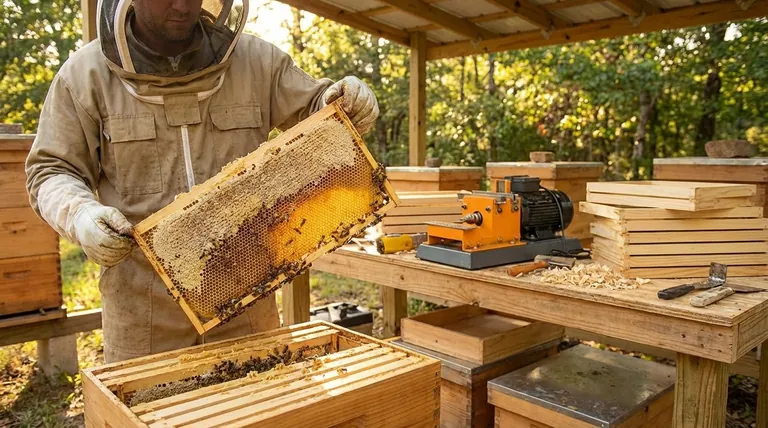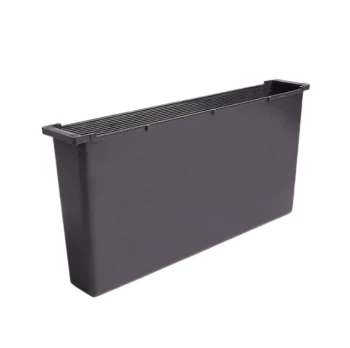On average, a single Langstroth beehive frame can yield between three and six pounds of extracted honey. The exact amount depends almost entirely on the frame's size, with deep frames holding the most and shallow frames holding the least.
While beekeepers often focus on a single number, the key is understanding that honey yield per frame is not a fixed value. It is a direct result of frame size, moderated by the health of your colony and the richness of your local environment.

A Guide to Honey Yield by Frame Size
The Langstroth hive is the most common system in modern beekeeping, and its frames come in three standard depths. Your honey yield is directly tied to which of these you use in your honey supers (the boxes dedicated to honey storage).
Langstroth Deep Frames (9 1/8")
A fully capped deep frame will yield approximately six pounds of extracted honey. These are the largest and heaviest frames.
While they offer the highest yield per frame, they are more commonly used for the brood chamber where the queen lays her eggs. A full super of deep frames can weigh over 60 pounds and is very difficult to lift.
Langstroth Medium Frames (6 1/4")
A fully capped medium frame yields around four pounds of honey. Some estimates place this slightly higher, at 4.2 pounds, but four is a reliable figure for forecasting.
This size is often considered the "goldilocks" for honey supers. It provides a good amount of honey at a more manageable weight, with a full box typically weighing around 40 pounds.
Langstroth Shallow Frames (5 3/8")
A fully capped shallow frame will produce roughly three pounds of honey. These are the lightest frames available.
Their primary advantage is their low weight, making them the easiest to handle. A full shallow super is the most manageable, weighing about 30-35 pounds.
Factors That Influence Your Final Yield
The estimates above assume ideal conditions. In practice, several variables determine whether a frame reaches its full potential.
The Importance of "Capped" Honey
These figures are for fully capped frames. Bees cap honey with a layer of beeswax only when the honey has been dehydrated to the correct moisture content (below 18.6%). Harvesting uncapped honey can lead to fermentation and spoilage.
Colony Strength and Population
A strong, populous hive has a larger workforce of forager bees. More foragers mean more nectar is collected during a honey flow, leading to frames being filled and capped much faster.
Nectar Flow and Environment
Honey production is entirely dependent on the nectar flow, which is the period when local flowers are producing abundant nectar. The intensity and duration of this flow are dictated by weather, rainfall, and the types of plants available to your bees.
Understanding the Trade-offs: Frame Size and Usability
Choosing a frame size for your honey supers involves more than just calculating potential yield. Practical considerations are just as important.
The Weight Factor
The single biggest trade-off is weight. While a deep frame holds twice the honey of a shallow frame, a full box of them is extremely heavy and can be a significant physical challenge for the beekeeper. Many beekeepers choose smaller frames purely for ease of handling.
Equipment Standardization
Many beekeepers choose to use a single frame size—typically mediums—for both their brood boxes and their honey supers. This simplifies management significantly, as any frame can be used in any box, reducing the need for different types of equipment.
Making the Right Choice for Your Goals
Your decision on frame size should be based on your physical ability and management style.
- If your primary focus is maximizing yield per frame: Deep frames offer the most honey, but be prepared for their significant weight during inspection and harvest.
- If your primary focus is a balance of yield and ease of use: Medium frames are the industry standard for a reason, offering a good harvest at a manageable weight.
- If your primary focus is having the lightest possible equipment: Shallow frames are the easiest to handle, making beekeeping more accessible if lifting is a concern.
By understanding these variables, you can accurately forecast your hive's potential and choose the right equipment for your beekeeping journey.
Summary Table:
| Frame Size (Depth) | Average Honey Yield (Fully Capped) | Full Super Weight (Approx.) |
|---|---|---|
| Deep (9 1/8") | 6 lbs | Over 60 lbs |
| Medium (6 1/4") | 4 lbs | ~40 lbs |
| Shallow (5 3/8") | 3 lbs | 30-35 lbs |
Ready to equip your apiary for maximum honey production?
As a commercial beekeeper or distributor, your efficiency and yield are paramount. HONESTBEE supplies the durable, high-quality beekeeping equipment you rely on—from deep and medium frames to complete honey supers—through our wholesale-focused operations.
Let us help you standardize your equipment and optimize your harvest. Contact our wholesale team today to discuss your needs and request a quote.
Visual Guide

Related Products
- Mini Desktop Bee Hive Frame Forming Making Machine
- Professional In-Hive Bee Feeder HONESTBEE Frame for Beekeeping
- Plastic Bee Frame Beekeeping Hive Frames for Wholesale
- HONESTBEE Wired and Assembled Wooden Bee Frames Foundation for a Thriving Hive
- 3.5L Plastic Beehive Frame Feeder Deep Frame Water Feeder for In Hive Use
People Also Ask
- Why are Langstroth and Dadant beehive frames popular choices for honey extractors? Maximize Your Honey Yield with Standardized Equipment
- What is the role of oxalic acid in plants? A Key to Plant Defense and Internal Regulation
- How does a bee frame making machine work? A Guide to Automated Metal Frame Production
- How are Langstroth beehive frames assembled? A Step-by-Step Guide for a Durable Hive
- What are the advantages of using the Beehive Frame Making Machine? Boost Apiary Efficiency & Self-Sufficiency



















